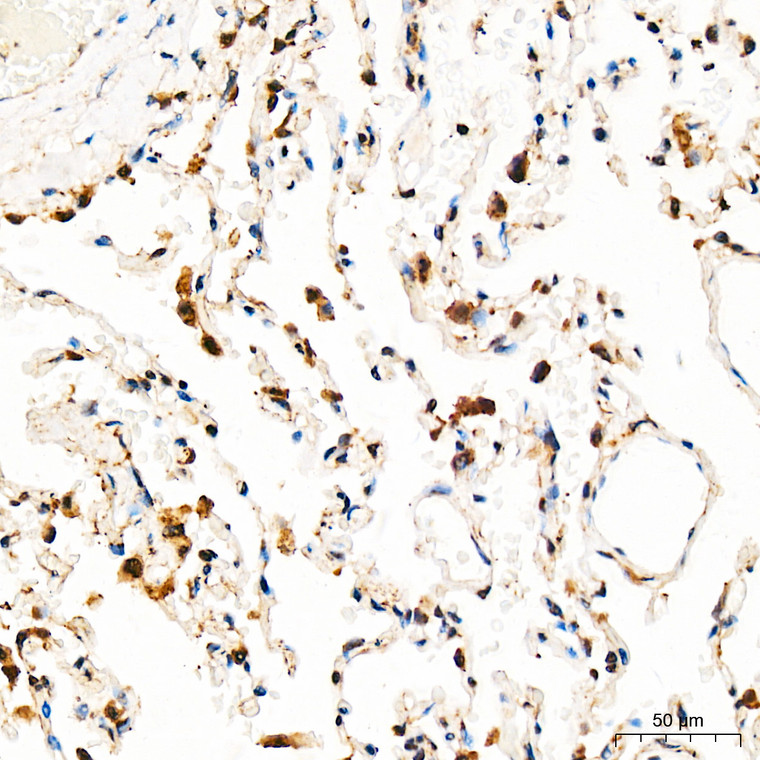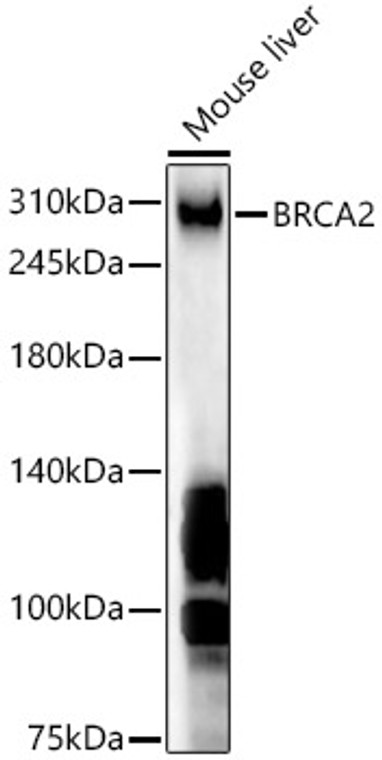| Host: |
Rabbit |
| Applications: |
WB/IF |
| Reactivity: |
Mouse/Rat |
| Note: |
STRICTLY FOR FURTHER SCIENTIFIC RESEARCH USE ONLY (RUO). MUST NOT TO BE USED IN DIAGNOSTIC OR THERAPEUTIC APPLICATIONS. |
| Short Description: |
Rabbit polyclonal antibody anti-BRCA2 (1400-1600) is suitable for use in Western Blot and Immunofluorescence research applications. |
| Clonality: |
Polyclonal |
| Conjugation: |
Unconjugated |
| Isotype: |
IgG |
| Formulation: |
PBS with 0.01% Thimerosal, 50% Glycerol, pH7.3. |
| Purification: |
Affinity purification |
| Dilution Range: |
WB 1:500-1:1000IF/ICC 1:50-1:200 |
| Storage Instruction: |
Store at-20°C for up to 1 year from the date of receipt, and avoid repeat freeze-thaw cycles. |
| Gene Symbol: |
BRCA2 |
| Gene ID: |
675 |
| Uniprot ID: |
BRCA2_HUMAN |
| Immunogen Region: |
1400-1600 |
| Immunogen: |
Recombinant fusion protein containing a sequence corresponding to amino acids 1400-1600 of BRCA2 (NP_000050.3). |
| Immunogen Sequence: |
KESFNKIVNFFDQKPEELHN FSLNSELHSDIRKNKMDILS YEETDIVKHKILKESVPVGT GNQLVTFQGQPERDEKIKEP TLLGFHTASGKKVKIAKESL DKVKNLFDEKEQGTSEITSF SHQWAKTLKYREACKDLELA CETIEITAAPKCKEMQNSLN N |
| Tissue Specificity | Highest levels of expression in breast and thymus, with slightly lower levels in lung, ovary and spleen. |
| Post Translational Modifications | Phosphorylated by ATM upon irradiation-induced DNA damage. Phosphorylation by CHEK1 and CHEK2 regulates interaction with RAD51. Phosphorylation at Ser-3291 by CDK1 and CDK2 is low in S phase when recombination is active, but increases as cells progress towards mitosis.this phosphorylation prevents homologous recombination-dependent repair during S phase and G2 by inhibiting RAD51 binding. Ubiquitinated in the absence of DNA damage.this does not lead to proteasomal degradation. In contrast, ubiquitination in response to DNA damage leads to proteasomal degradation. |
| Function | Involved in double-strand break repair and/or homologous recombination. Binds RAD51 and potentiates recombinational DNA repair by promoting assembly of RAD51 onto single-stranded DNA (ssDNA). Acts by targeting RAD51 to ssDNA over double-stranded DNA, enabling RAD51 to displace replication protein-A (RPA) from ssDNA and stabilizing RAD51-ssDNA filaments by blocking ATP hydrolysis. Part of a PALB2-scaffolded HR complex containing RAD51C and which is thought to play a role in DNA repair by HR. May participate in S phase checkpoint activation. Binds selectively to ssDNA, and to ssDNA in tailed duplexes and replication fork structures. May play a role in the extension step after strand invasion at replication-dependent DNA double-strand breaks.together with PALB2 is involved in both POLH localization at collapsed replication forks and DNA polymerization activity. In concert with NPM1, regulates centrosome duplication. Interacts with the TREX-2 complex (transcription and export complex 2) subunits PCID2 and SEM1, and is required to prevent R-loop-associated DNA damage and thus transcription-associated genomic instability. Silencing of BRCA2 promotes R-loop accumulation at actively transcribed genes in replicating and non-replicating cells, suggesting that BRCA2 mediates the control of R-loop associated genomic instability, independently of its known role in homologous recombination. |
| Protein Name | Breast Cancer Type 2 Susceptibility ProteinFanconi Anemia Group D1 Protein |
| Database Links | Reactome: R-HSA-5685939Reactome: R-HSA-5685942Reactome: R-HSA-5693554Reactome: R-HSA-5693568Reactome: R-HSA-5693579Reactome: R-HSA-5693616Reactome: R-HSA-912446Reactome: R-HSA-9701192Reactome: R-HSA-9704331Reactome: R-HSA-9704646Reactome: R-HSA-9709275Reactome: R-HSA-9709570Reactome: R-HSA-9709603Reactome: R-HSA-9763198 |
| Cellular Localisation | NucleusCytoplasmCytoskeletonMicrotubule Organizing CenterCentrosomeColocalizes With Ercc5/Xpg To Nuclear Foci Following Dna Replication Stress |
| Alternative Antibody Names | Anti-Breast Cancer Type 2 Susceptibility Protein antibodyAnti-Fanconi Anemia Group D1 Protein antibodyAnti-BRCA2 antibodyAnti-FACD antibodyAnti-FANCD1 antibody |
Information sourced from Uniprot.org
12 months for antibodies. 6 months for ELISA Kits. Please see website T&Cs for further guidance









